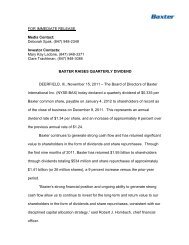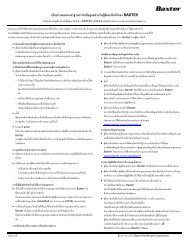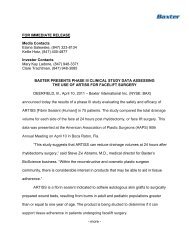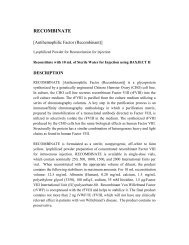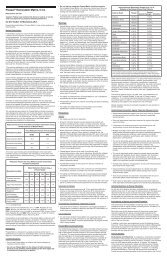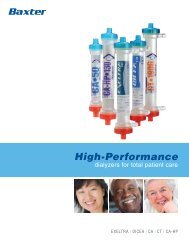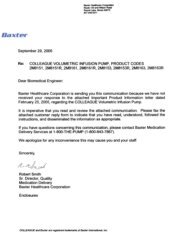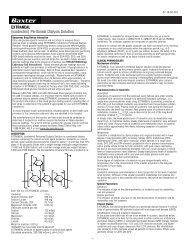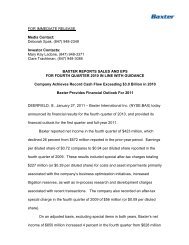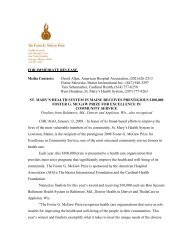Recombinant - Baxter
Recombinant - Baxter
Recombinant - Baxter
Create successful ePaper yourself
Turn your PDF publications into a flip-book with our unique Google optimized e-Paper software.
RECOMBINATE<br />
[Antihemophilic Factor (<strong>Recombinant</strong>)]<br />
Lyophilized Powder for Reconstitution for injection<br />
Reconstitute with 5 mL of Sterile Water for Injection using BAXJECT II<br />
DESCRIPTION<br />
RECOMBINATE [Antihemophilic Factor (<strong>Recombinant</strong>)] is a glycoprotein<br />
synthesized by a genetically engineered Chinese Hamster Ovary (CHO) cell line.<br />
In culture, the CHO cell line secretes recombinant Factor VIII (rFVIII) into the<br />
cell culture medium. The rFVIII is purified from the culture medium utilizing a<br />
series of chromatography columns. A key step in the purification process is an<br />
immunoaffinity chromatography methodology in which a purification matrix,<br />
prepared by immobilization of a monoclonal antibody directed to Factor VIII, is<br />
utilized to selectively isolate the rFVIII in the medium. The synthesized rFVIII<br />
produced by the CHO cells has the same biological effects as human Factor VIII.<br />
Structurally the protein has a similar combination of heterogenous heavy and light<br />
chains as found in human Factor VIII.<br />
RECOMBINATE is formulated as a sterile, nonpyrogenic, off-white to faint<br />
yellow, lyophilized powder preparation of concentrated recombinant Factor VIII<br />
for intravenous injection. RECOMBINATE is available in single-dose vials,<br />
which contain nominally 250, 500, 1000, 1500, and 2000 International Units per<br />
vial. When reconstituted with the appropriate volume of diluent, the product<br />
contains the following stabilizers in maximum amounts: For 5 mL reconstitution<br />
volume: 25 mg/mL Albumin (Human), 0.40 mg/mL calcium, 3 mg/mL<br />
polyethylene glycol (3350), 360 mEq/L sodium, 110 mM histidine, 1.5 µg/Factor<br />
VIII International Unit (IU) polysorbate-80. <strong>Recombinant</strong> Von Willebrand Factor<br />
(rVWF) is coexpressed with the rFVIII and helps to stabilize it. The final product<br />
contains not more than 2 ng rVWF/IU rFVIII, which will not have any clinically<br />
relevant effect in patients with von Willebrand’s disease. The product contains no<br />
preservative.
Each vial of RECOMBINATE is labeled with the Factor VIII activity expressed in<br />
IU per vial. Biological potency is determined by an in vitro assay which is<br />
referenced to the World Health Organization (WHO) International Standard for<br />
Factor VIII:C Concentrate.<br />
CLINICAL PHARMACOLOGY<br />
Factor VIII is the specific clotting factor deficient in patients with hemophilia A<br />
(classical hemophilia). Hemophilia A is a genetic bleeding disorder characterized<br />
by hemorrhages, which may occur spontaneously or after minor trauma. The<br />
administration of RECOMBINATE provides an increase in plasma levels of<br />
Factor VIII and can temporarily correct the coagulation defect in these patients.<br />
Pharmacokinetic studies on sixty-nine (69) patients revealed the circulating mean<br />
half-life for RECOMBINATE to be 14.6 ± 4.9 hours (n=67), which was not<br />
statistically significantly different from plasma-derived HEMOFIL M,<br />
[Antihemophilic Factor (Human), Method M, Monoclonal Purified]. The mean<br />
half-life of HEMOFIL M was 14.7 ± 5.1 hours (n=61). The actual baseline<br />
recovery observed with RECOMBINATE was 123.9 ± 47.7 IU/dL (n=23), which<br />
is significantly higher than the actual HEMOFIL M baseline recovery of 101.7 ±<br />
31.6 IU/dL (n=61). However, the calculated ratio of actual to expected recovery<br />
with RECOMBINATE (121.2 ± 48.9%) is not different on average from<br />
HEMOFIL M (123.4 ± 16.4%).<br />
The clinical study of RECOMBINATE in previously treated patients (individuals<br />
with hemophilia A who had been treated with plasma derived Factor VIII) was<br />
based on observations made on a study group of 69 patients. These individuals<br />
received cumulative amounts of Factor VIII ranging from 20,914 to 1,383,063 IU<br />
over the 48 month study. Patients were given a total of 17,700 infusions totaling<br />
28,090,769 IU RECOMBINATE.<br />
These patients were successfully treated for bleeding episodes on a demand basis<br />
and also for the prevention of bleeds (prophylaxis). Spontaneous bleeding<br />
episodes successfully managed include hemarthroses, soft tissue and muscle<br />
bleeds. Management of hemostasis was also evaluated in surgeries. A total of 24<br />
procedures on 13 patients were performed during this study. These included minor
(e.g. tooth extraction) and major (e.g. bilateral osteotomies, thoracotomy and liver<br />
transplant) procedures. Hemostasis was maintained perioperatively and<br />
postoperatively with individualized Factor VIII replacement.<br />
A study of RECOMBINATE in previously untreated patients was also performed<br />
as part of an ongoing study. The study group was comprised of seventy-nine (79) 1<br />
patients, of whom seventy-six (76) had received at least one infusion of<br />
RECOMBINATE. To date, this cohort has been given 12,209 infusions totaling<br />
over 11,277,043 IU of RECOMBINATE. Hemostasis was appropriately managed<br />
in spontaneous bleeding episodes, intracranial hemorrhage and surgical<br />
procedures.<br />
INDICATIONS and USAGE<br />
The use of RECOMBINATE [Antihemophilic Factor (<strong>Recombinant</strong>)] is indicated<br />
in hemophilia A (classical hemophilia) for the prevention and control of<br />
hemorrhagic episodes. 2 RECOMBINATE is also indicated in the perioperative<br />
management of patients with hemophilia A (classical hemophilia).<br />
RECOMBINATE can be of therapeutic value in patients with acquired Factor VIII<br />
inhibitors not exceeding 10 Bethesda Units per mL. 3 In clinical studies with<br />
RECOMBINATE, patients with inhibitors who were entered into the previously<br />
treated patient trial and those previously untreated children who have developed<br />
inhibitor activity on study, showed clinical hemostatic response when the titer of<br />
inhibitor was less than 10 Bethesda Units per mL. However, in such uses, the<br />
dosage of RECOMBINATE should be controlled by frequent laboratory<br />
determinations of circulating Factor VIII levels as well as the clinical status of the<br />
patient.<br />
RECOMBINATE is not indicated in von Willebrand’s disease.<br />
CONTRAINDICATIONS<br />
RECOMBINATE is contraindicated in patients who have manifested lifethreatening<br />
immediate hypersensitivity reactions, including anaphylaxis, to the<br />
product or its components, including bovine, mouse or hamster proteins.
WARNINGS<br />
General<br />
The clinical response to RECOMBINATE may vary. If bleeding is not controlled<br />
with the recommended dose, the plasma level of factor VIII should be determined<br />
and a sufficient dose of RECOMBINATE should be administered to achieve a<br />
satisfactory clinical response. If the patient’s plasma factor VIII level fails to<br />
increase as expected or if bleeding is not controlled after the expected dose, the<br />
presence of an inhibitor (neutralizing antibodies) should be suspected and<br />
appropriate testing performed. (see PRECAUTIONS - Monitoring Laboratory<br />
Tests).<br />
Anaphylaxis and Severe Hypersensitivity Reactions<br />
Allergic type hypersensitivity reactions, including anaphylaxis, have been reported<br />
with RECOMBINATE and have been manifested as dizziness, pruritus, rash,<br />
urticaria, flushing, angioedema/face swelling, laryngeal edema, dyspnea, pallor,<br />
pyrexia, nausea, paresthesia, hypotension, and loss of consciousness. Discontinue<br />
RECOMBINATE if symptoms occur and seek immediate emergency treatment.<br />
RECOMBINATE contains trace amounts of bovine proteins, mouse<br />
immunoglobulin G (MuIgG), and hamster (CHO) proteins. Patients treated with<br />
this product may develop hypersensitivity to these non-human mammalian<br />
proteins.<br />
Neutralizing Antibodies<br />
Patients treated with antihemophilic factor (AHF) products should be carefully<br />
monitored for the development of factor VIII inhibitors by appropriate clinical<br />
observations and laboratory tests. Inhibitors have been reported following<br />
administration of RECOMBINATE predominantly in previously untreated and<br />
minimally treated patients. The risk of developing inhibitors is highest during the<br />
first 20 exposure days. If expected plasma factor VIII activity levels are not<br />
attained, or if bleeding is not controlled with an expected dose, an assay that<br />
measures factor VIII inhibitor concentration should be performed (see<br />
PRECAUTIONS - Monitoring Laboratory Tests).
PRECAUTIONS<br />
General<br />
Certain components used in the packaging of this product contain natural rubber<br />
latex.<br />
Identification of the clotting defect as a Factor VIII deficiency is essential<br />
before the administration of RECOMBINATE [Antihemophilic Factor<br />
(<strong>Recombinant</strong>)] is initiated. No benefit may be expected from this product in<br />
treating other deficiencies.<br />
Formation of Antibodies to Mouse, Hamster or Bovine Protein<br />
As RECOMBINATE contains trace amounts of mouse protein (maximum of 0.1<br />
ng/IU RECOMBINATE), hamster protein (maximum of 1.5 ng CHO protein/IU<br />
RECOMBINATE), and bovine protein (maximum of 1 ng BSA/IU<br />
RECOMBINATE), the remote possibility exists that patients treated with this<br />
product may develop hypersensitivity to these non-human mammalian proteins.<br />
Information for Patients<br />
The patient and physician should discuss the risks and benefits of this product.<br />
Allergic type hypersensitivity reactions have been observed with<br />
RECOMBINATE. Patients should be informed of the early signs of<br />
hypersensitivity reactions including hives, generalized urticaria, tightness of the<br />
chest, wheezing, hypotension, symptoms of laryngeal edema, and anaphylaxis.<br />
Patients should be advised to discontinue use of the product and contact their<br />
physician if these symptoms occur. Additionally, patients should be informed that<br />
local tissue irritation may occur when infusing RECOMBINATE reconstituted<br />
with 5 mL sWFI.<br />
Monitoring Laboratory Tests<br />
Monitor plasma factor VIII activity levels by the one-stage clotting assay<br />
to confirm the adequate factor VIII levels have been achieved and<br />
maintained, when clinically indicated. (see DOSAGE and<br />
ADMINISTRATION).
Monitor for development of factor VIII inhibitors. Perform assay to<br />
determine if factor VIII inhibitor is present if expected factor VIII activity<br />
plasma levels are not attained, or if bleeding is not controlled with the<br />
expected dose of RECOMBINATE. Use Bethesda Units (BU) to titer<br />
inhibitors.<br />
o If the inhibitor is less than 10 BU per mL, the administration of<br />
additional RECOMBINATE concentrate may neutralize the<br />
inhibitor, and may permit an appropriate hemostatic response.<br />
o Adequate hemostasis may not be achieved if inhibitor titers are<br />
above 10 BU per mL. The inhibitor titer may rise following<br />
RECOMBINATE infusion as a result of an anamnestic response to<br />
factor VIII. The treatment or prevention of bleeding in such<br />
patients requires the use of alternative therapeutic approaches and<br />
agents.<br />
Carcinogenesis, Mutagenesis, Impairment of Fertility<br />
RECOMBINATE was tested for mutagenicity at doses considerably exceeding<br />
plasma concentrations of Factor VIII in vitro and at doses up to ten times the<br />
expected maximum clinical dose in vivo, and did not cause reverse mutations,<br />
chromosomal aberrations, or an increase in micronuclei in bone marrow<br />
polychromatic erythrocytes. Long-term studies in animals have not been<br />
performed to evaluate carcinogenic potential.<br />
Pediatric Use<br />
RECOMBINATE is appropriate for use in children of all ages, including the<br />
newborn. Safety and efficacy studies have been performed in both previously<br />
treated (n=23) and previously untreated (n=75) children. (See CLINICAL<br />
PHARMACOLOGY and PRECAUTIONS).<br />
Pregnancy<br />
Pregnancy Category C. Animal reproduction studies have not been conducted<br />
with RECOMBINATE. The safety of RECOMBINATE for use in pregnant<br />
women has not been established. It is not known whether RECOMBINATE can<br />
cause fetal harm when administered to a pregnant woman or can affect<br />
reproductive capacity. Physicians should carefully consider the potential risks and
enefits for each specific patient before prescribing RECOMBINATE.<br />
RECOMBINATE should be given to a pregnant woman only if clearly needed.<br />
Nursing Mothers<br />
It is not known whether this drug is excreted into human milk. Because many<br />
drugs are excreted into human milk, caution should be exercised if<br />
RECOMBINATE is administered to nursing mothers. RECOMBINATE should<br />
be given to nursing mothers only if clinically needed.<br />
ADVERSE REACTIONS<br />
Adverse Reactions from Clinical Trials<br />
During controlled clinical studies with RECOMBINATE enrolling 210 subjects,<br />
the most commonly reported adverse drug reactions were chills, flushing, rash<br />
and epistaxis.<br />
System Organ Class<br />
(SOC)<br />
GASTROINTESTINAL<br />
DISORDERS<br />
GENERAL<br />
DISORDERS AND<br />
ADMINISTRATION<br />
SITE CONDITIONS<br />
INFECTIONS AND<br />
INFESTATIONS<br />
Preferred MedDRA<br />
Term<br />
Number of<br />
Subjects<br />
Percent of<br />
Evaluable<br />
Subjects *<br />
Nausea 1 0.48<br />
Chills<br />
Fatigue<br />
Pyrexia<br />
INVESTIGATIONS Acoustic stimulation<br />
tests abnormal<br />
MUSCULOSKELETAL<br />
AND CONNECTIVE<br />
TISSUES DISORDERS<br />
NERVOUS SYSTEM<br />
DISORDERS<br />
RESPIRATORY,<br />
THORACIC AND<br />
MEDIASTINAL<br />
DISORDERS<br />
SKIN AND<br />
SUBCUTANEOUS<br />
3<br />
1<br />
1<br />
1.43<br />
0.48<br />
0.48<br />
Ear infections 1 0.48<br />
1 0.48<br />
Pain in extremity 1 0.48<br />
Dizziness<br />
Tremors<br />
Pharyngolaryngeal<br />
pain<br />
Hyperhidrosis<br />
Pruritus<br />
1<br />
1<br />
0.48<br />
0.48<br />
1 0.48<br />
1<br />
1<br />
0.48<br />
0.48
System Organ Class<br />
(SOC)<br />
Preferred MedDRA<br />
Term<br />
TISSUE DISORDERS Rash<br />
Rash maculopapular<br />
VASCULAR<br />
DISORDERS<br />
Epistaxis<br />
Flushing<br />
Hematoma<br />
Hypotension<br />
Pallor<br />
Peripheral coldness<br />
Number of<br />
Subjects<br />
2<br />
1<br />
1 †<br />
2<br />
1<br />
1<br />
1<br />
1<br />
Percent of<br />
Evaluable<br />
Subjects *<br />
0.95<br />
0.48<br />
0.48<br />
0.95<br />
0.48<br />
0.48<br />
0.48<br />
0.48<br />
* Number of evaluable subjects experiencing the event/total number of evaluable subjects<br />
[% relative to 210, the total number of unique subjects who received at least 1 infusion of<br />
RECOMBINATE].<br />
†One subject experienced 11 events of epistaxis.<br />
During the Previously Treated Patients (PTP) study, none of the 71 subjects<br />
developed de novo evidence of Factor VIII inhibitor. However, during the phase<br />
II/III portion of the study, 1 subject with a history of inhibitors exhibited inhibitor<br />
activity at 6 months (0.8 Bethesda Units [BU]), which resolved by 9 months. One<br />
other subject in this study had detectable Factor VIII inhibitor at baseline (1.26<br />
BU) and exhibited an anamnestic response at 6 months (10.3 BU). During a<br />
prospective pharmaco-surveillance study of subjects who received batches of<br />
RECOMBINATE containing modestly increased Chinese Hamster Ovary (CHO)<br />
cell protein levels, none of the 34 treated subjects developed a Factor VIII<br />
inhibitor.<br />
During the Previously Untreated Patients (PUP) study, 22 of the 73 evaluable<br />
subjects developed inhibitors to Factor VIII. Of these, 13 subjects displayed no<br />
detectable Factor VIII inhibitors at study exit.<br />
Post-Marketing Adverse Reactions<br />
In addition to the adverse reactions noted in clinical trials, the following adverse<br />
reactions have been reported in the post-marketing experience. These adverse<br />
reactions are listed by MedDRA (version 12.1) System Organ Class (SOC), then<br />
by MedDRA coding system Preferred Term in order of severity.<br />
BLOOD AND LYMPHATIC SYSTEM DISORDERS: Factor VIII inhibition<br />
CARDIAC DISORDERS: Tachycardia, Cyanosis<br />
GASTROINTESTINAL DISORDERS: Vomiting, Abdominal pain<br />
GENERAL DISORDERS AND ADMINISTRATION SITE CONDITIONS:<br />
Malaise, Injection site reactions, Chest pain, Chest discomfort<br />
IMMUNE SYSTEM DISORDERS: Anaphylactic reaction, Hypersensitivity
NERVOUS SYSTEM DISORDERS: Loss of consciousness, Headache,<br />
Paresthesia<br />
RESPIRATORY, THORACIC AND MEDIASTINAL DISORDERS:<br />
Dyspnea, Cough, Laryngeal edema<br />
SKIN AND SUBCUTANEOUS TISSUE DISORDERS: Angioedema,<br />
Urticaria, Erythema<br />
DOSAGE and ADMINISTRATION<br />
Each vial of RECOMBINATE is labeled with the Factor VIII activity expressed in<br />
IU per vial. This potency assignment is referenced to the World Health<br />
Organization International Standard for Factor VIII:C Concentrate and is<br />
evaluated by appropriate methodology to ensure accuracy of the results.<br />
The expected in vivo peak increase in Factor VIII level expressed as IU/dL of<br />
plasma or % (percent) of normal can be estimated by multiplying the dose<br />
administered per kg body weight (IU/kg) by two. This calculation is based on the<br />
clinical findings of Abildgaard et al 4 and is supported by the data generated by<br />
419 clinical pharmacokinetic studies with RECOMBINATE in 67 patients over<br />
time. This pharmacokinetic data demonstrated a peak recovery point above the<br />
pre-infusion baseline of approximately 2.0 IU/dL per IU/kg body weight.<br />
Examples (Assuming patient’s baseline Factor VIII level is at
Early hemarthrosis or muscle<br />
bleed or oral bleed<br />
More extensive hemarthrosis,<br />
muscle bleed, or hematoma<br />
Life threatening bleeds such as<br />
head injury, throat bleed, severe<br />
abdominal pain<br />
Surgery<br />
Type of operation<br />
Minor surgery, including tooth<br />
extraction<br />
20-40<br />
30-60<br />
60-100<br />
60-80<br />
Major surgery 80-100<br />
(pre- and post-operative)<br />
Begin infusion every 12 to 24 hours<br />
for one-three days until the bleeding<br />
episode is resolved (as indicated by<br />
pain), or healing is achieved.<br />
Repeat infusion every 12 to 24<br />
hours for (usually) three days or<br />
more until pain and disability are<br />
resolved.<br />
Repeat infusion every 8 to 24 hours<br />
until threat is resolved.<br />
A single infusion plus oral<br />
antifibrinolytic therapy within one<br />
hour is sufficient in approximately<br />
70% of cases.<br />
Repeat infusion every 8 to 24 hours<br />
depending on state of healing<br />
If bleeding is not controlled with the recommended dose, the plasma level of<br />
Factor VIII should be determined and a sufficient dose of RECOMBINATE<br />
should be administered to achieve a satisfactory clinical response.<br />
The careful control of the substitution therapy is especially important in cases of<br />
major surgery or life threatening hemorrhages. In presence of a low titer inhibitor,<br />
doses larger than those recommended may be necessary as per standard care.<br />
Although dosage can be estimated by the calculations above, it is strongly<br />
recommended that whenever possible, appropriate laboratory tests including serial<br />
Factor VIII assays be performed on the patient’s plasma at suitable intervals to<br />
assure that adequate Factor VIII levels have been reached and are maintained.<br />
Patients should be evaluated for the development of Factor VIII inhibitors, if the<br />
expected plasma Factor VIII activity levels are not attained, or if bleeding is not<br />
controlled with an appropriate dose.<br />
Reconstitution: Use Aseptic Technique
1. Bring RECOMBINATE (dry factor concentrate) and Sterile Water for<br />
Injection, USP, (diluent) to room temperature.<br />
2. Remove caps from concentrate and diluent vials.<br />
3. Cleanse stoppers with germicidal solution and allow to dry prior to use. Place<br />
vials on a flat surface.<br />
4. Open the BAXJECT II device package by peeling away the lid, without<br />
touching the inside. Do not remove the device from the package.<br />
5. Turn the package over. Press straight down to fully insert the clear plastic<br />
spike through the diluent vial stopper.<br />
6. Grip the BAXJECT II package at its edge and pull the package off the device.<br />
Do not remove the blue cap from the BAXJECT II device. Do not touch<br />
the exposed white plastic spike.<br />
7. Turn the system over, so that the diluent vial is on top. Quickly insert the<br />
white plastic spike fully into the RECOMBINATE vial stopper by pushing<br />
straight down. The vacuum will draw the diluent into the RECOMBINATE<br />
vial.<br />
8. Swirl gently until RECOMBINATE is completely dissolved. After<br />
reconstitution, the solution should be colorless to faint yellow, and<br />
substantially free from foreign particles.<br />
NOTE: Do not refrigerate after reconstitution. (see Administration)<br />
Administration: Use Aseptic Technique<br />
RECOMBINATE is administered by intravenous (IV) injection after<br />
reconstitution.<br />
Administer at room temperature.<br />
RECOMBINATE should be administered not more than 3 hours after<br />
reconstitution.<br />
Intravenous Syringe Injection<br />
Parenteral drug products should be inspected for particulate matter and<br />
discoloration prior to administration, whenever solution and container permit. The<br />
solution should be colorless to faint yellow in appearance. If not, do not use the<br />
solution and notify <strong>Baxter</strong> immediately.<br />
Plastic syringes are recommended for use with this product since proteins such as<br />
RECOMBINATE tend to stick to the surface of glass syringes.
1. Remove the blue cap from the BAXJECT II device. Connect the syringe<br />
to the BAXJECT II device. DO NOT INJECT AIR.<br />
2. Turn over the connected vials so that the RECOMBINATE vial is on top.<br />
Draw the factor concentrate into the syringe by pulling the plunger back<br />
slowly.<br />
3. Disconnect the syringe; attach a suitable needle and inject intravenously as<br />
instructed under Rate of Administration.<br />
4. If a patient is to receive more than one vial of RECOMBINATE, the<br />
contents of multiple vials may be drawn into the same syringe. Please<br />
note that the BAXJECT II device is intended for use with a single vial<br />
of RECOMBINATE and Sterile Water for Injection only, therefore<br />
reconstituting and withdrawing a second vial into the syringe requires<br />
a second BAXJECT II device.<br />
Rate of Administration<br />
The rate of administration should be a rate that ensures the comfort of the patient.<br />
Preparations of RECOMBINATE can be administered at a rate of up to 5 mL per<br />
minute when reconstituted with 5 mL of sWFI.<br />
The pulse rate should be determined before and during administration of<br />
RECOMBINATE. Should a significant increase in pulse rate occur, reducing the<br />
rate of administration or temporarily halting the injection usually allows the<br />
symptoms to disappear promptly.<br />
HOW SUPPLIED<br />
RECOMBINATE is available in five different strengths in single-dose vials. The<br />
strength is designated on the outer box and on the vial label using the following<br />
color codes:<br />
Color Code Dosage Strength RECOMBINATE Supplied with<br />
5 mL sWFI<br />
Light blue bar 220 – 400 IU per vial NDC 0944-2841-10<br />
Pink bar 401-800 IU per vial NDC 0944-2842-10<br />
Green bar 801-1240 IU per vial NDC 0944-2843-10<br />
Purple bar 1241-1800 IU per vial NDC 0944-2844-10
Orange bar 1801-2400 IU per vial NDC 0944-2845-10<br />
RECOMBINATE is packaged with 5 mL of Sterile Water for Injection, USP, a<br />
BAXJECT II Needleless Transfer Device, one physician insert and one patient<br />
insert.<br />
Storage<br />
RECOMBINATE can be refrigerated [2° - 8°C (36° - 46°F)] or stored at room<br />
temperature, not to exceed 30°C (86°F). Avoid freezing to prevent damage to the<br />
diluent vial. Do not use beyond the expiration date printed on the box.<br />
CLINICAL STUDIES<br />
Over the investigational period of the original safety and efficacy study of<br />
RECOMBINATE, none of the 69 subjects without an inhibitor at entry into the<br />
study, developed an inhibitor. In the previously untreated patient group there<br />
were 73 eligible subjects with Factor VIII levels less than or equal to 2% who<br />
received at least one RECOMBINATE treatment (median days 100, range 3-821)<br />
and who were tested for an inhibitor after treatment with RECOMBINATE. Of<br />
this group, 23 individuals (32%) developed a detectable inhibitor (median days on<br />
treatment at time of detection 10, range 3-69) and of these, 8 subjects (11%)<br />
showed a titer greater than 10 B.U.<br />
REFERENCES<br />
1. Bray GL, Gomperts ED, Courter S, Gruppo R, et al: A Multicenter Study of<br />
<strong>Recombinant</strong> Factor VIII (Recombinate): Safety, Efficacy, and Inhibitor Risk<br />
in Previously Untreated Patients with Hemophilia A Blood 83:2428-2435,<br />
1994<br />
2. White GC, McMillan CW, Kingdon HS, et al: Use of recombinant<br />
antihemophilic factor in the treatment of two patients with classic hemophilia.<br />
New Eng J Med 320:166-170, 1989<br />
3. Kessler CM: An Introduction to Factor VIII Inhibitors: The Detection and<br />
Quantitation. Am J Med 91 (Suppl 5A): 1S-5S, 1991
4. Abildgaard CF, Simone JV, Corrigan JJ, et al: Treatment of hemophilia with<br />
glycine-precipitated Factor VIII. New Eng J Med 275:471-475, 1966<br />
To enroll in the confidential, industry-wide Patient Notification System, call 1-<br />
888-UPDATE U (1-888-873-2838).<br />
<strong>Baxter</strong>, Recombinate, Hemofil, and Baxject are trademarks of <strong>Baxter</strong> International<br />
Inc.<br />
Manufactured by:<br />
<strong>Baxter</strong> Healthcare Corporation<br />
Westlake Village, CA 91362 USA<br />
U.S. License No. 140<br />
Printed in USA<br />
Issued: Dec 2010
Patient Information<br />
RECOMBINATE<br />
[Antihemophilic Factor (<strong>Recombinant</strong>)]<br />
This leaflet summarizes important information about RECOMBINATE. Please<br />
read it carefully before using this medicine. This information does not take the<br />
place of talking with your healthcare provider, and it does not include all of the<br />
important information about RECOMBINATE. If you have any questions after<br />
reading this, ask your healthcare provider.<br />
Do not attempt to self-infuse unless you have been taught how by your doctor<br />
or hemophilia center.<br />
What is RECOMBINATE [Antihemophilic Factor (<strong>Recombinant</strong>)]?<br />
RECOMBINATE is a medicine used to replace a clotting factor (Factor VIII or<br />
antihemophilic factor) that is missing in people with hemophilia A (also called<br />
“classic” hemophilia). Hemophilia A is an inherited bleeding disorder that<br />
prevents blood from clotting normally.<br />
RECOMBINATE is used to prevent and control bleeding in people with<br />
hemophilia A.<br />
RECOMBINATE is not used to treat von Willebrand’s Disease.<br />
Who should not use RECOMBINATE [Antihemophilic Factor<br />
(<strong>Recombinant</strong>)]?<br />
You should not use RECOMBINATE if you<br />
are allergic to mouse, hamster or bovine proteins.<br />
are allergic to any ingredients in RECOMBINATE (such as calcium,<br />
histidine, human albumin, polyethylene glycol, polysorbate-80 and<br />
sodium).<br />
Tell your healthcare provider if you are pregnant or breast-feeding because<br />
RECOMBINATE may not be right for you.
How should I use RECOMBINATE [Antihemophilic Factor<br />
(<strong>Recombinant</strong>)]?<br />
RECOMBINATE is given directly into the blood stream.<br />
You may infuse RECOMBINATE at a hemophilia treatment center, at your<br />
healthcare provider’s office or in your home. You should be trained on how to do<br />
infusions by your hemophilia treatment center or healthcare provider. Many<br />
people with hemophilia A learn to infuse their RECOMBINATE by themselves or<br />
with the help of a family member.<br />
You must carefully follow your doctor’s or other healthcare provider’s<br />
instructions regarding the dose and schedule for infusing RECOMBINATE so that<br />
your treatment will work best for you.<br />
Your healthcare provider will tell you how much RECOMBINATE to use based<br />
on your weight, the severity of your hemophilia A, and where you are bleeding.<br />
You may have to have blood tests done after getting RECOMBINATE to be sure<br />
that your blood level of Factor VIII is high enough to clot your blood.<br />
Call your healthcare provider right away if your bleeding does not stop after<br />
taking RECOMBINATE.<br />
What should I tell my healthcare provider before I use RECOMBINATE<br />
[Antihemophilic Factor (<strong>Recombinant</strong>)]?<br />
You should tell your healthcare provider if you<br />
have or have had any medical problems.<br />
take any medicines, including non-prescription medicines, dietary<br />
supplements and herbal remedies.<br />
have any allergies, including allergies to mouse, hamster or bovine<br />
proteins.<br />
are nursing.<br />
are pregnant or planning to become pregnant.<br />
have been told that you have inhibitors to Factor VIII (because Factor VIII<br />
may not work for you).<br />
What are the possible side effects of RECOMBINATE [Antihemophilic<br />
Factor (<strong>Recombinant</strong>)]?<br />
You could have an allergic reaction to RECOMBINATE.<br />
Call your healthcare provider right away and stop treatment if you get a:<br />
Rash or hives
itching<br />
tightness of the throat<br />
chest pain or tightness<br />
difficulty breathing<br />
light-headed, dizziness<br />
fainting<br />
The most common side effects are chills, flushing, rash and nose bleeds. . These<br />
are not all possible side effects with RECOMBINATE. You can ask your<br />
healthcare provider for information that is written for healthcare professionals.<br />
Tell your doctor about any side effect that bothers you or that does not go away.<br />
What are the RECOMBINATE [Antihemophilic Factor (<strong>Recombinant</strong>)]<br />
dosage strengths?<br />
RECOMBINATE comes in five different dosage strengths. The actual strength<br />
will be imprinted on the label and on the box. The five different strengths are<br />
coded, as follows:<br />
Light-blue<br />
Pink<br />
Green<br />
Purple<br />
Orange<br />
Nominal dosage strength of approximately 250 IU per vial (220 –<br />
400 IU/vial).<br />
Nominal dosage strength of approximately 500 IU per vial (401 –<br />
800 IU/vial).<br />
Nominal dosage strength of approximately 1000 IU per vial (801 –<br />
1240 IU/vial).<br />
Nominal dosage strength of approximately 1500 IU per vial<br />
(1241-1800 IU/vial)<br />
Nominal dosage strength of approximately 2000 IU per vial<br />
(1801-2400 IU/vial)<br />
Always check the potency printed on the label to make sure you are using the<br />
strength prescribed by your doctor. Always check the expiration date printed on<br />
the box. You should not use the product after the expiration date printed on the<br />
box.
How do I store RECOMBINATE [Antihemophilic Factor (<strong>Recombinant</strong>)]?<br />
RECOMBINATE vials containing powdered product (without sterile diluent<br />
added) should be stored in a refrigerator (2° to 8°C [36° to 46°F]) or at room<br />
temperature (up to 30°C [86°F]).<br />
If you choose to store RECOMBINATE at room temperature:<br />
it should remain at room temperature until infused.<br />
do not put room temperature product back in the refrigerator.<br />
Store vials in their original box and protect them from extreme exposure to light.<br />
Do not freeze.<br />
Reconstituted product (after mixing dry product with wet diluent) must be used<br />
within 3 hours and cannot be stored or refrigerated. Any RECOMBINATE left in<br />
the vial at the end of your infusion should be discarded.<br />
What else should I know about RECOMBINATE [Antihemophilic Factor<br />
(<strong>Recombinant</strong>)] and hemophilia A?<br />
Your body may form inhibitors to Factor VIII. An inhibitor is part of the body’s<br />
normal defense system. If you form inhibitors, it may stop RECOMBINATE from<br />
working properly. Call your healthcare provider right away if your bleeding does<br />
not stop after taking RECOMBINATE. Consult with your healthcare provider to<br />
make sure you are carefully monitored with blood tests for the development of<br />
inhibitors to Factor VIII.<br />
Resources at <strong>Baxter</strong> available to the patients:<br />
Contact <strong>Baxter</strong> to receive more product information:<br />
<strong>Baxter</strong> Customer Service 1-800-423-2090<br />
Issued: Dec 2010
INSTRUCTIONS FOR USE<br />
RECOMBINATE<br />
[Antihemophilic Factor (<strong>Recombinant</strong>)]<br />
(For intravenous use only)<br />
Do not attempt to do an infusion to yourself unless you have been taught how by your<br />
doctor or hemophilia center.<br />
1. In a quiet place, prepare a clean flat surface and gather all the materials you will need for<br />
the infusion. Check the expiration date, and let the vial with the RECOMBINATE<br />
concentrate and the Sterile Water for Injection, USP (diluent) warm up to room<br />
temperature. Wash your hands and put on clean exam gloves. If infusing yourself at<br />
home, the use of gloves is optional.<br />
2. Remove caps from the RECOMBINATE concentrate and diluent vials to expose the<br />
centers of the rubber stoppers.
3. Disinfect the stoppers with an alcohol swab (or other suitable solution suggested by your<br />
doctor or hemophilia center) by rubbing the stoppers firmly for several seconds, and<br />
allow to dry prior to use. Place the vials on a flat surface.<br />
4. Open the BAXJECT II device package by peeling away the lid, without touching the<br />
inside of the package. Do not remove the BAXJECT II device from the package.<br />
5. Turn the package with the BAXJECT II device upside down, and place it over the top of<br />
the diluent vial. Fully insert the clear plastic spike of the device into the center of the<br />
diluent vial’s stopper by pushing straight down. Grip the package at its edge and lift it off<br />
the device. Be careful not to touch the white plastic spike. Do not remove the blue cap<br />
from the BAXJECT II device.<br />
The diluent vial now has the BAXJECT II device connected to it and is ready to be connected<br />
to the RECOMBINATE vial.
6. To connect the diluent vial to the RECOMBINATE vial, turn the diluent vial over and<br />
place it on top of the vial containing RECOMBINATE concentrate. Fully insert the white<br />
plastic spike into the RECOMBINATE vial’s stopper by pushing straight down. Diluent<br />
will flow into the RECOMBINATE vial. This should be done right away to keep the<br />
liquid free of germs.<br />
7. Swirl the connected vials gently and continuously until the RECOMBINATE is<br />
completely dissolved. Do not shake. The RECOMBINATE solution should be colorless<br />
to light-yellow in appearance. If not, do not use it and notify <strong>Baxter</strong> immediately.
8. Take off the blue cap from the BAXJECT II device and connect the syringe. BE<br />
CAREFUL TO NOT INJECT AIR.<br />
9. Turn over the connected vials so that the RECOMBINATE vial is on top. Draw the<br />
RECOMBINATE solution into the syringe by pulling back the plunger slowly.<br />
Disconnect the syringe from the vials. Attach the infusion needle to the syringe using a<br />
winged (butterfly) infusion set, if available. Point the needle up and remove any air<br />
bubbles by gently tapping the syringe with your finger and slowly and carefully pushing<br />
air out of the syringe and needle.<br />
If you are using more than one vial of RECOMBINATE, the contents of more than one vial<br />
may be drawn into the same syringe. However, you will need a separate diluent and<br />
BAXJECT II device to mix each additional vial of RECOMBINATE.<br />
10. Apply a tourniquet, and get the injection site ready by wiping the skin well with an<br />
alcohol swab (or other suitable solution suggested by your doctor or hemophilia center).
11. Insert the needle into the vein, and remove the tourniquet. Slowly infuse the<br />
RECOMBINATE. Do not infuse any faster than 5 mL per minute for<br />
RECOMBINATE dissolved with 5 mL of sWFI. Redness of the skin or irritation may<br />
be seen when infusing RECOMBINATE dissolved with 5 mL diluent.<br />
12. Take the needle out of the vein and use sterile gauze to put pressure on the infusion site<br />
for several minutes.<br />
Do not recap the needle. Place it with the used syringe in a hard-walled Sharps<br />
container for proper disposal.<br />
13. Remove the peel-off label from the RECOMBINATE vial and place it in your logbook.<br />
Clean any spilled blood with a freshly prepared mixture of 1 part bleach and 9 parts<br />
water, soap and water, or any household disinfecting solution.
14. Dispose of the used vials and BAXJECT II system in your hard-walled Sharps container,<br />
without taking them apart. Do not dispose of these supplies in ordinary household trash.<br />
Important: Contact your doctor or local Hemophilia Treatment Center if you experience<br />
any problems.<br />
<strong>Baxter</strong>, Recombinate, Hemofil, and Baxject are trademarks of <strong>Baxter</strong> International Inc.<br />
Manufactured by:<br />
<strong>Baxter</strong> Healthcare Corporation<br />
Westlake Village, CA 91362 USA<br />
U.S. License No. 140<br />
Printed in USA



